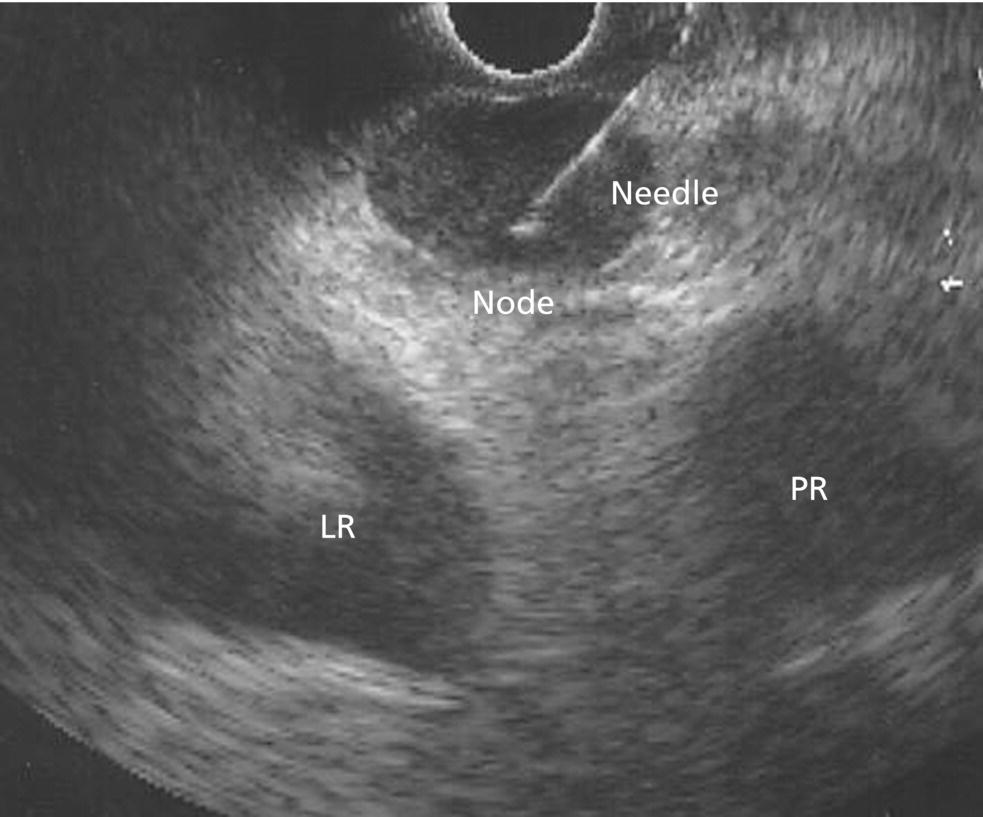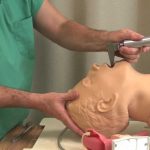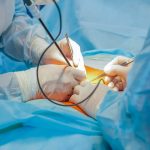This test combines ultrasound and endoscopy. It helps your doctor to look through the wall of the food pipe at the surrounding tissue. The main airway (windpipe) is close to the food pipe.
A doctor or a specialist nurse (endoscopist) does the test. To do the test the endoscopist uses a long flexible tube called an endoscope. They pass the endoscope down your throat into your food pipe. It has a tiny camera and light on the end and an ultrasound probe attached. The ultrasound scan uses high frequency sound waves to create a picture of the inside of your body.
The endoscopist might use a special needle passed out of the end of the endoscope to take small tissue samples (biopsies).
You have this test with a local anaesthetic  and light sedation
and light sedation  .
.
Why do I need an endoscopic ultrasound?
An endoscopic ultrasound (EUS) can check whether lung cancer and mesothelioma has spread. It checks for signs of cancer in the lymph nodes  in the centre of the chest close to the windpipe.
in the centre of the chest close to the windpipe.
What do I need to do to prepare for an endoscopic ultrasound?
You’ll be given written instructions on how to prepare for your endoscopic ultrasound. For example, they will ask you not to eat and drink for a few hours before the test.
Take your usual medicines as normal unless your doctor tells you otherwise. If you take warfarin or other blood thinners to thin your blood, you need to stop this before your test. Your doctor will tell you when to stop them.
What happens on the day?
Before the test
When you arrive at the outpatient department the nurse takes some measurements. This includes your blood pressure, heart and breathing rate, your oxygen level and weight.
You’ll see your endoscopist who will explain what’s going to happen and ask you to sign a consent form. This is a good time to ask any questions you may have.
You may need to change into a hospital gown, or you might be able to stay in your own clothes.
Having a local anaesthetic with a light sedation
The nurse takes you to the test room. You have the procedure on a couch lying down on your left side.
You will have a sedative. This will help you to relax and can make you feel sleepy, but you will be able to answer questions. You have the sedative through a small tube into your vein (cannula).
The endoscopist will numb your throat using a local anaesthetic. They will either use a spray or a spray and gel. This can make you cough; your eyes may water and you may have a bitter taste in your mouth.
Once this is working you may feel like you can’t swallow but you can.
The nurse or endoscopist also places a mouthguard in the area the endoscope will travel down.
Attached to one of your fingers is a clip to monitor your heart rate and oxygen levels throughout the test.
During the test
The endoscopist puts the endoscope into your mouth and gently down your throat. This is a bit uncomfortable, and you might gag, but it doesn’t last long and shouldn’t hurt because you have had the local anaesthetic. You can breathe normally.
The endoscopist then looks for anything abnormal and can take tissue samples (biopsies) to test.
Your nurse or anaesthetist checks your oxygen levels and heart rate using the clip on your finger.
After the test
Afterwards, you’ll feel sleepy. A nurse will monitor you in the recovery area until you are awake enough to leave.
You won’t be able to eat or drink anything until the local anaesthetic wears off. This is because your throat is too numb to swallow safely at first. This usually passes after about an hour.
The nurse will remove the cannula before you are ready to leave.
Going home
You can usually go home the same day. If you take blood thinners your endoscopist or nurse will tell you when to restart them. This is usually the next day. Someone should collect you from the hospital and stay with you overnight if you have had a sedative.
You shouldn’t drive or drink alcohol for 24 hours after having a sedative. You also shouldn’t operate heavy machinery or sign any important documents.
You need to take things easy for a day or so. You might have a sore throat for a couple of days.
Possible risks
An endoscopy is a very safe procedure. But your nurse tells you who to contact if you have any problems afterwards. Your doctors make sure the benefits of having an endoscopy outweigh the possible risks.
The possible risks include:
A sore throat
You might have a sore throat for up to 24 hours. Contact the hospital if you have severe pain in your throat, chest or tummy (abdomen).
Bleeding
There is a risk of bleeding from the biopsy site. This is usually a small amount and stops on its own. Rarely you may need a blood transfusion.
Small tear in the food pipe
There is a risk of a small tear (perforation) in the food pipe. This is rare. If it happened, you would need to stay in hospital and have antibiotics and possibly an operation to repair the tear.
Fluid going into your lungs
There is a very small risk of fluid going into your lungs from your mouth during the test. Your nurse uses a tube to remove most of the fluid from your mouth to reduce this risk.
Shortness of breath
A reaction to the sedative can cause breathing difficulties but this is rare. Your nurse checks your oxygen levels during the test. You have oxygen through a tube that fits into your nose (nasal cannulae).

Getting your results
You should get your results within 1 to 2 weeks. The doctor who arranged your endoscopy gives them to you.
Waiting for results can make you anxious. You can ask your doctor or nurse how long it takes to get them. Contact the doctor who arranged the test if you haven’t heard anything after a couple of weeks.




